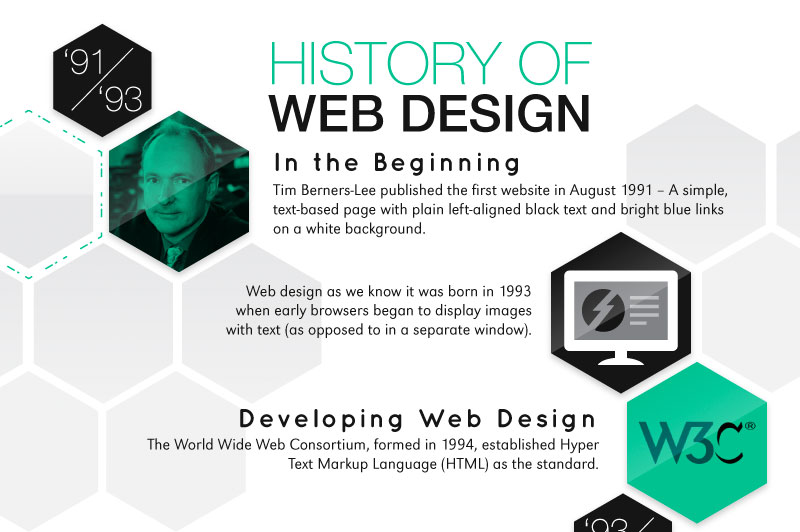The Evolution Of Internet Site Layout: From Past To Existing
The Evolution Of Internet Site Layout: From Past To Existing
Blog Article
Writer-Bradshaw Hejlesen
In the past, sites were easy and focused on information. Navigating was straight, and style was for desktop computers. Currently, user experience is essential. Data guides layouts for simple navigation. Receptive formats suit different tools. Today, dark mode decreases strain, and minimalist menus boost navigation. Interactive attributes engage customers, and bold visuals attract attention. AI assimilation improves involvement. See exactly how layout has actually progressed to improve your on-line journey.
Early Days of Web Design
In the very early days of web design, simpleness preponderated. Web sites were fundamental, with minimal shades, font styles, and designs. The emphasis was on providing information as opposed to fancy visuals. Individuals accessed the net via sluggish dial-up links, so rate and capability were vital.
Navigation food selections were straightforward, normally located at the top or side of the page. Internet sites were made for computer, as mobile surfing had not been yet prevalent. Material was king, and developers prioritized easy readability over complex layout elements.
HTML was the key coding language used, and designers needed to work within its restrictions. Computer animations and interactive attributes were very little contrasted to today's requirements. Web sites were static, with little dynamic material or customized individual experiences.
Rise of User-Focused Design
With the development of website layout, a change in the direction of user-focused design principles has ended up being significantly prominent. Today, creating websites that prioritize user experience is essential for involving visitors and accomplishing organization goals. User-focused design involves recognizing the needs, choices, and behaviors of your target audience to tailor the web site's design, web content, and features as necessary.
Developers now conduct complete research study, such as user surveys and usability screening, to collect understandings and feedback straight from customers. This data-driven approach helps in producing intuitive navigating, clear calls-to-action, and aesthetically appealing interfaces that resonate with site visitors. By positioning the customer at the facility of the design procedure, internet sites can deliver an extra tailored and delightful experience.
Responsive style has additionally become a vital facet of user-focused layout, ensuring that internet sites are maximized for various gadgets and display dimensions. This versatility improves availability and usability, accommodating the diverse methods individuals communicate with web sites today. In essence, the increase of user-focused design signifies a change towards creating electronic experiences that prioritize the demands and expectations of completion individual.
Modern Trends in Website Design
Explore the current fads shaping website design today. One prominent trend is dark setting layout, offering a streamlined and modern-day look while decreasing eye stress in low-light environments. Another crucial fad is minimalist navigation, simplifying food selections and boosting user experience by concentrating on essential elements. Incorporating https://www.dentaleconomics.com/practice/marketing/article/14223127/5-proven-ways-to-boost-your-dental-seo-rankings -interactions, such as computer animated switches or scrolling effects, can create an extra appealing and interactive website. Receptive design continues to be crucial, making sure smooth individual experiences across different gadgets. Additionally, utilizing strong typography and asymmetrical layouts can add visual rate of interest and accentuate details web content.
Incorporating AI innovation, like chatbots for customer support or personalized recommendations, boosts individual involvement and improves procedures. Ease of access has likewise become a considerable pattern, with developers focusing on comprehensive layout practices to accommodate diverse individual demands. Welcoming sustainability by enhancing site performance for rate and effectiveness is one more emerging fad in web design. Teaming up with user responses and information analytics to repeat and enhance layout continually is important for remaining relevant in the ever-evolving digital landscape. By accepting these contemporary trends, you can develop a visually appealing, straightforward internet site that resonates with your target market.
Final thought
As you assess the evolution of site design from the early days to now, you can see how user-focused design has actually come to be the driving force behind modern-day patterns.
Accept the trip of change and adaptation in website design, always maintaining the individual experience at the leading edge.
Tippingpointdigital
Keep present with the latest trends and innovations, and never ever stop evolving your strategy to develop aesthetically magnificent and user-friendly web sites.
Develop, adapt, and create - the future of website design remains in your hands.
